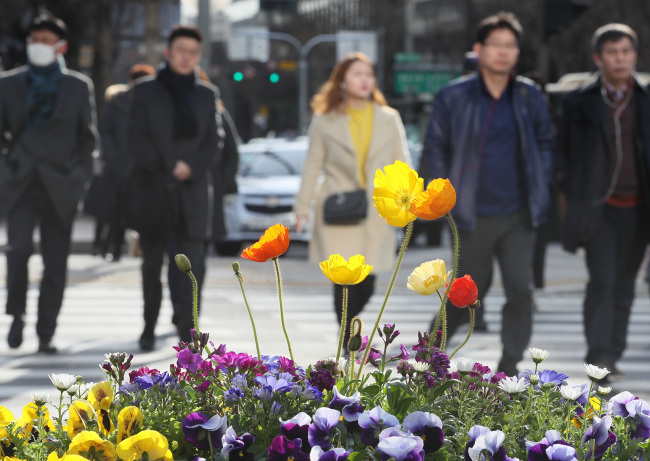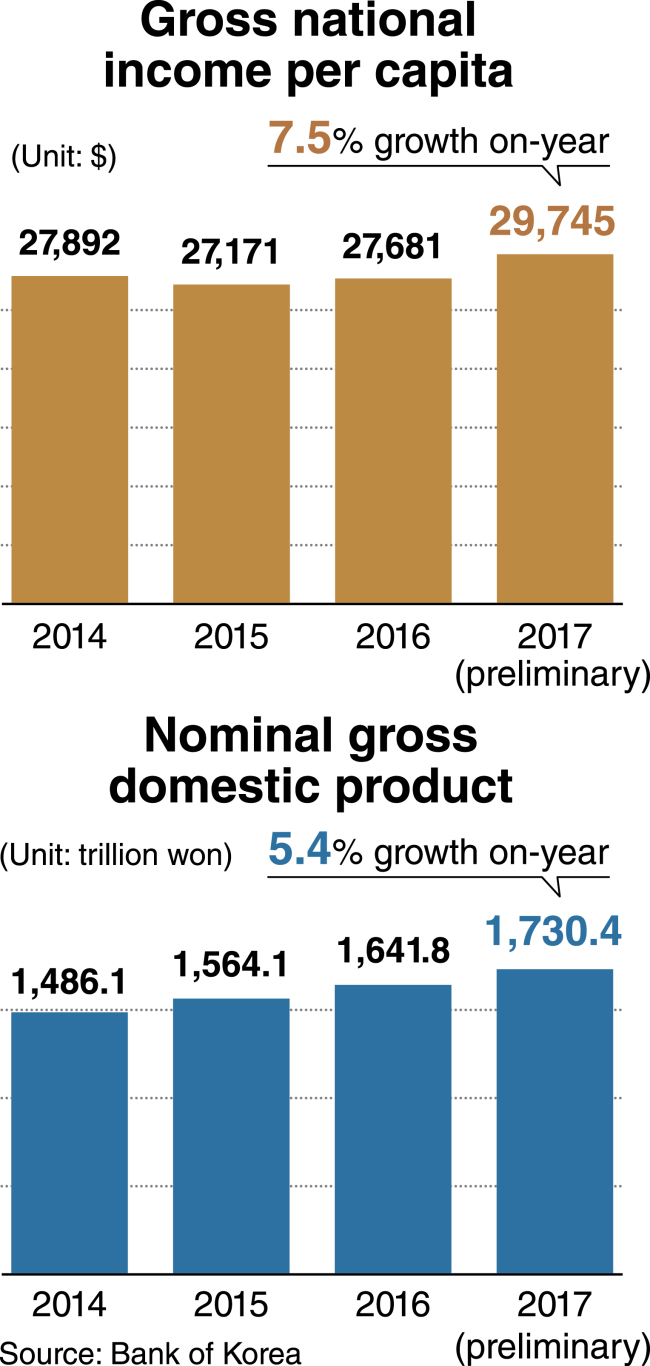South Korea‘s nominal gross national income per capita came to $29.745 as of 2017 upon the sharpest on-year rise in six years, while the national economy grew by 3.1 percent, preliminary data by the Bank of Korea showed Wednesday.
Such robust macroeconomic readings indicate Asia’s fourth largest economy is on track to be placed on par with developed nations, giving the country more room to carry out stronger measures for social welfare, according to the central bank.
Such robust macroeconomic readings indicate Asia’s fourth largest economy is on track to be placed on par with developed nations, giving the country more room to carry out stronger measures for social welfare, according to the central bank.

In 2017, Korea‘s GNI per capita, an indicator of the income level of citizens that is said to be highly associated with quality of life, accelerated 7.5 percent from the previous year, the sharpest surge since 9.6 percent in 2011.
Korea‘s personal gross disposable income per capita, indicating income available for the households for purchasing and saving, reached $16,573 in 2017, up 6.8 percent from 2016.
The steep rise came in part due to strong local currency, according to the central bank.
If termed in Korean won, Korea’s nominal GNI per capita rose 4.7 percent over the course of 2017, while GDI per capita increased 4.1 percent. The won-dollar foreign currency exchange rate fell 2.6 percent over the cited period.
Still, the indicator can be seen as a sign of improvement in quality of life, said Chung Kyu-il, director-general of Economic Statistics Department at the central bank, in a press briefing Wednesday.
Chung said Korea’s GNI per capita will certainly top $30,000 in 2018, adding the crossing of the $30,000-mark means “the average quality of life improved to a large extent, and (Korea) is following the stages of other advanced countries.”
“Now we can put more effort, time and money into individuals‘ well-being, a better environment and social welfare,” he added.
Korea’s GNI per capita surpassed $10,000 in 1994 and $20,000 in 2006, according to the BOK estimate.

The real GDP -- inflation-adjusted -- rose 3.1 percent year-on-year, indicating the national economy grew accordingly.
The BOK cited “increases in construction and facility investment growth and the expansion of private and government consumption” as reasons for real GDP growth.
Construction investment climbed 7.6 percent on more residential building construction, while facilities investment piled up 14.6 percent on an increase in investment into general machinery and precision instruments.
These indicators contributed to a rise of gross fixed capital formation in 2017 by 8.6 percent.
As for expenditure, private consumption rose 2.6 percent in 2017, while government spending jumped 3.4 percent.
By production, manufacturing advanced 4.4 percent, construction jumped 7.1 percent and services picked up 2.1 percent.
The BOK had been confident with the 3 percent growth in 2017, and had held on to the forecast that the national economy would also grow by “around 3 percent” this year.
The nominal gross savings ratio reached a 19-year high at 36.3 percent in 2017, up by 0.2 percentage points compared to a year prior. In the wake of a rise in the government‘s tax revenue last year, the ratio reached the highest since 1998, when it amounted to 38 percent.
By Son Ji-hyoung
(consnow@heraldcorp.com)
Korea‘s personal gross disposable income per capita, indicating income available for the households for purchasing and saving, reached $16,573 in 2017, up 6.8 percent from 2016.
The steep rise came in part due to strong local currency, according to the central bank.
If termed in Korean won, Korea’s nominal GNI per capita rose 4.7 percent over the course of 2017, while GDI per capita increased 4.1 percent. The won-dollar foreign currency exchange rate fell 2.6 percent over the cited period.
Still, the indicator can be seen as a sign of improvement in quality of life, said Chung Kyu-il, director-general of Economic Statistics Department at the central bank, in a press briefing Wednesday.
Chung said Korea’s GNI per capita will certainly top $30,000 in 2018, adding the crossing of the $30,000-mark means “the average quality of life improved to a large extent, and (Korea) is following the stages of other advanced countries.”
“Now we can put more effort, time and money into individuals‘ well-being, a better environment and social welfare,” he added.
Korea’s GNI per capita surpassed $10,000 in 1994 and $20,000 in 2006, according to the BOK estimate.

The real GDP -- inflation-adjusted -- rose 3.1 percent year-on-year, indicating the national economy grew accordingly.
The BOK cited “increases in construction and facility investment growth and the expansion of private and government consumption” as reasons for real GDP growth.
Construction investment climbed 7.6 percent on more residential building construction, while facilities investment piled up 14.6 percent on an increase in investment into general machinery and precision instruments.
These indicators contributed to a rise of gross fixed capital formation in 2017 by 8.6 percent.
As for expenditure, private consumption rose 2.6 percent in 2017, while government spending jumped 3.4 percent.
By production, manufacturing advanced 4.4 percent, construction jumped 7.1 percent and services picked up 2.1 percent.
The BOK had been confident with the 3 percent growth in 2017, and had held on to the forecast that the national economy would also grow by “around 3 percent” this year.
The nominal gross savings ratio reached a 19-year high at 36.3 percent in 2017, up by 0.2 percentage points compared to a year prior. In the wake of a rise in the government‘s tax revenue last year, the ratio reached the highest since 1998, when it amounted to 38 percent.
By Son Ji-hyoung
(consnow@heraldcorp.com)








![[KH Explains] Hyundai's full hybrid edge to pay off amid slow transition to pure EVs](http://res.heraldm.com/phpwas/restmb_idxmake.php?idx=644&simg=/content/image/2024/04/18/20240418050645_0.jpg&u=20240419100350)







![[From the Scene] Monks, Buddhists hail return of remains of Buddhas](http://res.heraldm.com/phpwas/restmb_idxmake.php?idx=652&simg=/content/image/2024/04/19/20240419050617_0.jpg&u=20240419175937)

![[KH Explains] Hyundai's full hybrid edge to pay off amid slow transition to pure EVs](http://res.heraldm.com/phpwas/restmb_idxmake.php?idx=652&simg=/content/image/2024/04/18/20240418050645_0.jpg&u=20240419100350)

![[Today’s K-pop] Illit drops debut single remix](http://res.heraldm.com/phpwas/restmb_idxmake.php?idx=642&simg=/content/image/2024/04/19/20240419050612_0.jpg&u=)